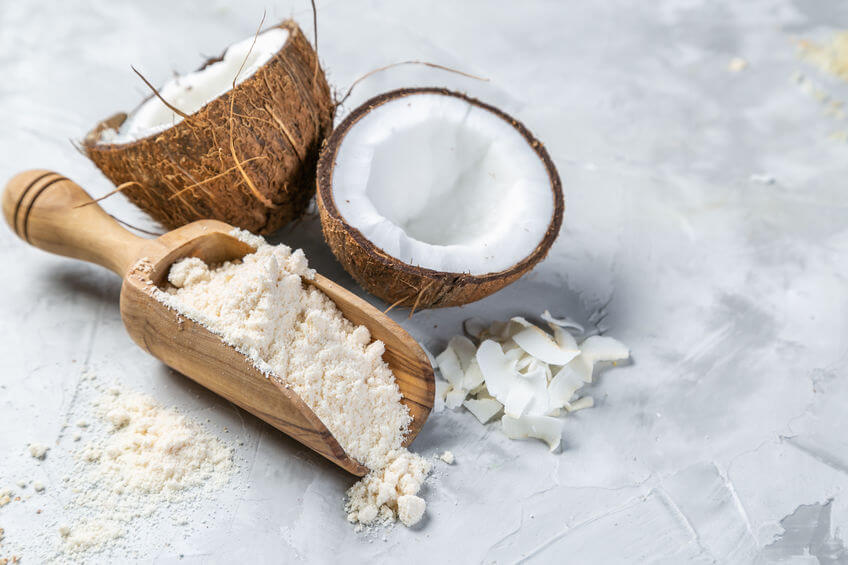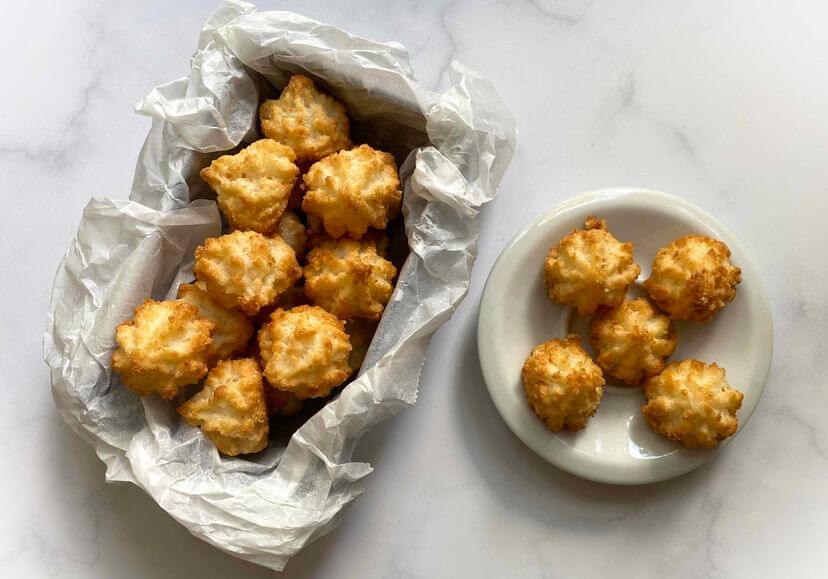Gluten-free diets have become more popular over the last several years, due in part to the rising number of people suffering from Celiac disease and gluten sensitivity. This could be related to increased gluten consumption or perhaps to the expanded cultivation of high-gluten wheat species that have innate insecticide properties. In short, many people are seeking gluten alternatives, and the uses for coconut flour as a substitute for wheat flour are definitely worth exploring!
There are many wheat flour alternatives to choose from, but coconut flour has quickly become a popular option — especially for baked goods — because of the many benefits it offers, such as:
- Low calories
- High fiber content
- MCTs (medium-chain triglycerides) that help with weight loss, heart health, and more
- Lower glycemic index of 51 (as opposed to 69 for wheat flour)
- Mild coconut flavor
Of course, coconut flour doesn’t directly substitute for wheat flour, so you’ll need to understand how to properly use it for best results. However, there are so many ways to incorporate it into your daily diet! Here’s what you need to know about uses for coconut flour so that you can make the most of this gluten-free product.
Substituting Coconut Flour for Wheat Flour

While there are many uses for coconut flour, it’s very different from the all-purpose flour that most consumers are used to.
Coconut flour is made by removing moisture from coconut meat — typically through pressing — and then drying the meat and grinding it into a fine, soft powder.
This process creates a very dry product, which means that it can’t be substituted on a 1:1 ratio for wheat flour or other flour types.
Accounting For Moisture
Generally speaking, you’ll substitute just ¼ cup of coconut flour for one cup of whole wheat or all-purpose flour in traditional recipes.
In addition, you’ll need to add an equal amount of liquid to balance the dryness of the flour.
Often, bakers will add an egg for every ¼ cup of coconut flour, as this also helps to replace some of the binding properties that you lose when gluten is left out of the equation.
Other liquids you might add to create the right consistency include water, milk, coconut oil, coconut milk, or even pureed fruit (think applesauce), depending on the types of flavors you want to stand out in your recipe.
The trick is to allow the dough to rest for a few minutes after mixing everything to let the flour absorb then liquid, then see if you need to adjust your amounts to create the desired consistency for your dough or batter.
Labelling
Before you get started experimenting with coconut flour in your favorite recipes, be sure to take the time to read your product labels.
What you’re likely to find is that many products that claim to be coconut flour actually have other flour types included, as well as additives like fillers, sugar, and flavoring.
In order to make proper substitutions for recipes, you need pure coconut flour.
Storage
You’ll also want to store coconut flour properly.
It’s fine to leave it in the cupboard with other dry goods before opening the package, but once you’ve opened the package, you’ll want to store it in the fridge (for up to six months) or the freezer (for up to a year) to ensure optimal freshness.
Uses for Coconut Flour in Baking

One of the best uses for coconut flour is in baked goods.
For one thing, you may enjoy the subtle coconut flavor that it adds (although it’s also easy to cover the coconut taste if you want to, especially with a strong flavor profile like chocolate.)
It’s also a soft flour, with a fine texture that won’t create a grainy final product, unlike some other alternative flour options.
Desserts
So, what types of baked goods can you make with coconut flour? It can be used for virtually any type of baked good, including:
- Cookies
- Cakes
- Brownies
- Muffins
- Biscuits
- Breads
- And more
Bob’s Red Mill, a popular producer of alternative flours (including organic coconut flour), suggests recipes for baked goods that lean heavily into coconut flavor, such as:
- Coconut layer cake
- Coconut curry muffins
They also offer up plenty of options for breakfast goodies, like:
- Pancakes
- Crepes
- Tortillas
Breads, Crust & Dough
Coconut flour is incredibly versatile.
While you might expect it to create a rather dense baked good — and it’s certainly ideal for cookies and brownies — proper substitution with appropriate liquids can help to ensure that you get:
- Fluffy cakes
- Springy breads
- Doughy pizza crust
- And more
If you start looking around for bread recipes, you’ll find that coconut flour is a popular substitute for paleo, keto, and low-carb recipes, making it a great option for all kinds of diets.
Other Uses for Coconut Flour in Cooking
Beyond baking, you might be curious about other uses for coconut flour in the kitchen. As it turns out, you can use it pretty much any way that you’d use regular flour.
Breading & Dredging
For example, it’s a great option when you need to dredge meats like fish or chicken when you want a crusted fillet.
Because coconut flour is so absorbent, it will soak up liquids. It can get a bit mushy during frying though, so baking may be a better option here.
As A Binding Agent
Coconut flour can also be used as a binder for burgers, meatloaf, meatballs, and more, just like regular flour or breadcrumbs.
Soups & Sauces
It makes for a great addition to soups, stews, or sauces that you want to thicken, as well.
You could even use it to create a perfect, gluten-free béchamel, which could then be used in a variety of ways (for creamy, baked mac and cheese, for example).
You’ll just want to keep in mind that this flour does have a mild coconut flavor. While this works in your favor if you’re making a curry soup, for example, it might not be ideal for every recipe.
In this case, simply make sure to use ingredients, such as spices, that will overpower the coconut and deliver the flavor profile you prefer.
Coconut Flour Beauty Products

If you already use coconut oil to condition your hair or remove stubborn eye makeup, you know that coconut byproducts can leave your skin and hair soft and smelling lovely.
It should come as no surprise, then, that uses for coconut flour extend far beyond the kitchen.
Whether you use every part of whole coconuts at home — including drying and grinding coconut meat to make your own flour — or you simply purchase ready-made coconut flour at your local market, you can use it as part of your natural beauty routine.
Face & Body Scrubs
Although coconut flour is fine, much like all-purpose flour, it can be used in face or body scrubs to thicken the formula and add a pleasant scent.
For example, you could pair coconut flour with sugar or sea salt (or both) as the base of a scrub, adding vegetable oil (or coconut oil) for moisture.
This simple scrub can be used as is, or you could add any number of other ingredients for different effects.
Adding raw honey, for example, imbues your scrub with antibacterial properties that can help to reduce redness and lingering acne spots (although it doesn’t specifically treat active acne.)
Conclusion
As you can see, there’s no shortage of uses for coconut flour. Whether you rely on it to create delicious, gluten-free baked goods, use it to bread or bind meat recipes, or add it to your rotation of natural, homemade beauty products; the addition of coconut flour to your pantry will definitely yield some outstanding results.

